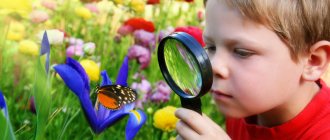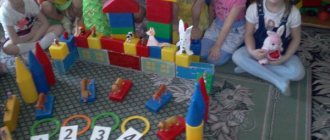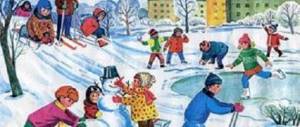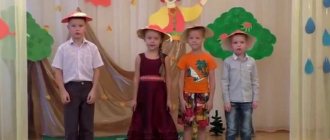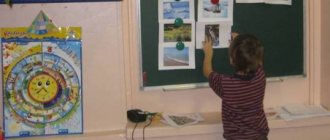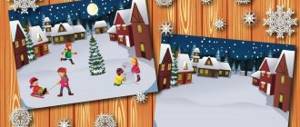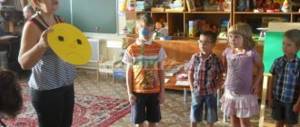Didactic games for preschoolers on the topic: Animals
Didactic games for kindergarten on the topic: “Animals”
Author: Knis Anna Nikolaevna, senior teacher. Place of work: MBDOU “Kindergarten No. 3 “Smile”, Kalach - on - Don. Description of work : I bring to your attention didactic games for preschoolers on the topic: “Animals”. This material will help educators, children and their parents consolidate children’s knowledge about wild and domestic animals and their cubs in a playful way. Didactic game: lotto “Animals”.
Goal: To consolidate children’s knowledge about animals, the ability to distinguish and find the right animal. Didactic material: Game field (4 pcs.), divided into 6 squares with images of various animals, corresponding to the images on small cards (24 pcs.). Progress of the game: Game for children from 3 years old. The game can be played by 3-5 people. Players are given game cards. The presenter pulls out a small card from a special opaque bag, the player or the presenter names the animal. Whoever finds the corresponding image on his field takes the picture for himself. This continues until one of the participants covers the entire playing field with chips. For children over 5 years old, the game can be complicated. Name in one word the animals depicted on the same playing field. The first field shows: cat, pig, horse, cow, goat, sheep. These are pets. The second field depicts: deer, squirrel, elk, fox, wild boar, wolf. These are forest animals. The third field depicts: sloth, echidna, platypus, kiwi, iguana, koala. These are the animals of Australia. The fourth field depicts: lion, rhinoceros, giraffe, camel, elephant, zebra. These are the animals of Africa. Didactic game “Who lives where?” Goal: To develop children’s skills to correlate images of animals with their habitat. Didactic material: Cards with images of animals, 24 pieces (taken from lotto) and two playing fields with images of a forest and a village.
Progress of the game: Arrange the cards according to the habitats of animals, domestic ones in the village, and wild ones in the forest. Didactic game “Guess what kind of animal” Goal: Developing the ability to describe animals and recognize them by description. Didactic material: Cards with images of animals. Progress of the game: The teacher distributes cards with images of animals to the children. Children do not show their cards to anyone. The teacher invites one child to describe the animal depicted in his picture, or to make a riddle about it. Other children must guess what kind of animal it is. Didactic game “Collect a picture” Goal: Development of logical thinking, outlook, cognitive interest and speech activity. Didactic material: Cards with images of animals, cut into several parts. Progress of the game: Game for children from 3 years old. Children are given game cards cut into 2, 3, 4 parts (according to the age and abilities of the child). Having collected the picture, the child tells what animal he collected. For example: A dog is a pet. The bear is a wild animal. Didactic game “The fifth odd one” Purpose: Development of skills to classify animals according to essential characteristics. Didactic material: Cards with images of 5 animals, 4 of them belong to one thematic group, and the fifth to another group. Progress of the game: Children are given the task: “Look at the pictures, name what is depicted on them and determine which animal is the odd one out. Call the remaining animals in one word.” Each participant eliminates the extra animal in turn. If he makes a mistake or does not complete the task, his version is offered to the next player to complete. For each correctly completed task they give a chip. The one who collects the most chips wins. Cards for the game: 1.Cat, fox, squirrel, wolf, bear. The extra porridge is because it is a domestic animal and the rest are wild animals.
2.Deer, tiger, dog, fox, lion. The extra dog is because it is a domestic animal and the rest are wild animals.
3. Pig, sheep, dog, fox, cat. The extra fox is because it is a wild animal and the rest are domestic animals.
4.Horse, zebra, cow, donkey, goat. The extra zebra is because it is a wild animal and the rest are domestic animals.
Didactic game “Whose Tail” Purpose: Development of attention, logic, memory, fine motor skills. Didactic material: Cards with images of various animals, as well as their tails. Progress of the game: The child is given a task. Choose a tail for each animal and connect the necessary pictures with lines. Name which animal has which tail (long, short, fluffy, thick, small, large, etc.).
Didactic game “Whose baby” Purpose: Development of observation, attention and analytical abilities. Didactic material: Cards with images of baby animals, 12 pieces and two playing fields with images of wild and domestic animals. Progress of the game: The guys have to help mothers find their babies. Also, when playing, you can reinforce the concept of big and small, domestic and wild animals in children. The game can be played by one to four people. Didactic game “Whose Shadow” Purpose: Development of logic, thinking and visual memory. Didactic material: Cards with images of various animals, as well as their shadows. Progress of the game: Invite the child to find where whose shadow is and connect the necessary pictures with lines.
Didactic game “What animals are hidden in the picture?” Goal: Development of attention, thinking, imagination. Didactic material: Cards depicting the outline of various animals. Progress of the game: Invite the child to find and name the animals drawn in the picture.
We recommend watching:
Didactic games with sand for children 3-4-5 years old Conversation for preschool children (4-6 years old) about animals Summary of a lesson on speech development and familiarization with the environment in the senior group Project for children of the senior group on the topic “Fauna and flora of the native the edges"
Similar articles:
Poems about pets for children 5-6 years old
Coloring pages “Wild animals” for children 5-7 years old
About the beaver for children 6-7 years old
A story about a monkey for children 6-7 years old
About possum for children
Didactic game “Whose baby”
Search Lectures
Educational games and tasks on the topic: “Spring”
- Tanya, what the pictures will tell us about in our lesson today. Look. - What are they telling us about? (That spring has come.) What is spring, what has it brought to us? We'll figure out.
— In spring it becomes warm, the last snow melts, streams run.
Didactic game “Dress up the doll”
— It was winter and Tanya wore warm clothes. Now it’s warmer and such clothes are no longer needed. Now we need different clothes. Choose clothes suitable for spring and dress your doll in them.
Drawing with paints “Streams are flowing”
— Take a brush in your hand, dip it first in water, then in blue paint. Now draw straight horizontal lines from the snow - the snow has melted and turned into streams.
The first flowers bloom in spring
Watching a blossoming apple tree branch
- Look at this thread. This is a branch from an apple tree. Now flowers will appear on it. Smell the scent of these flowers with your nose. Do you like this smell? And in the summer the apples will ripen, become yellow, tasty, and then we will eat them.
Application “Tree in Bloom”
Glue flowers to the background sheet with the image of the Tanya branch.
Didactic exercise “What first, what then”
- Tanya, look carefully at the pictures. First, the leaves bloomed on the apple tree, then the apple tree blossomed, flowers bloomed on its branches. Show me this picture. Then small green apples grew on the branches instead of flowers. Show me this picture. And then the apples ripened and became big and red. Show this picture. Now put the pictures in order - what happened first and what came next.
Button game “Spring flowers”
- And here the first flowers have appeared. In the picture with flowers, find a place for buttons. You must choose buttons by color and size.
Modeling "Violets"
Violets bloom in spring. let's make a thick sausage, this will be the stem. We will press a violet flower into it, which Tanya and I made from an egg cage. And now, from yellow plasticine, we will make the middle of the flower.
In spring it rains often, watering the ground
Game with clothespins “Clouds and sunshine”
Attach drop clothespins to the cloud. Tap your fingers on the table as if raindrops are falling to the ground. Now it’s raining heavily and our droplets are knocking hard and fast. Now the rain has begun to weaken, we knock quietly, rarely. The last drop has fallen, tap it once with your finger. So the sun came out. Let's make some rays for our sun from clothespins.
Exercise “Raindrops”
— After the rain, raindrops remained on the flowers and leaves. Take a pipette and use it to make droplets on the flowers.
Didactic game "Puddles"
— After the rain, all the holes filled with water and formed puddles. You need to apply blue puddles of the appropriate size to the black holes.
In the spring, animals wake up after hibernation, birds fly in
Construction of the "Birdhouse"
- Lay out a birdhouse using geometric shapes on a diagram sheet.
Drawing with pencils “Show the bird the way to the nest”
-Now show the birds the way to the nest. Draw lines so that all the birds fall into their nest.
Didactic exercise “Wake up sleeping animals”
— In winter, a hedgehog, a bear, a snake, and bees slept. Spring has come, the sun began to warm the earth, it became warm. Take the sun and put it on the picture. It's time to wake up for all the sleepyheads, for all those who slept in winter. Wake them up, say loudly: “Spring has come!” “It’s time to get up!” They didn't hear, say it louder. Let's clap our hands and stamp our feet. Finally, we woke up. Plant the bear near the tree. Place the hedgehog under a stump, put the snake on a stone, and let the bee fly to the very top, to the flowers on the trees.
In spring, many animals and birds give birth to babies.
Didactic game “Whose baby”
- Tanya, look, here we have a lot of adult animals and their babies. You must find each baby his mother. Be careful not to get confused.
(Didactic material and the child’s work are attached)
